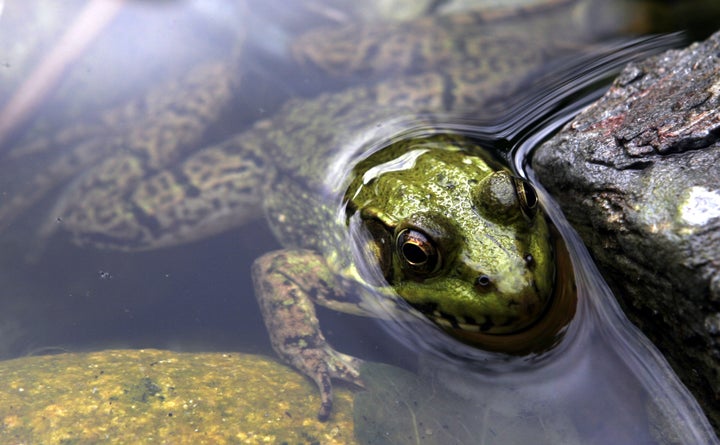
Jonathan Trouern-Trend, an intelligence sergeant with the Connecticut National Guard, was at the latrine of the U.S. military base near Al Bakr, Iraq, when he made a discovery: a Lemon-Yellow Tree Frog, one of Iraq’s eight species of amphibians, was sharing the bathroom with him. According to Trouern-Trend, the frog had likely been sucked up from a nearby pond by a cleaning truck, which then deposited the frog inside the bathroom when workers hosed down the facilities.
Trouern-Trend, concerned that the midday heat would render the oven-like latrine uninhabitable for amphibians (not to mention human beings), sprang into action. He captured the frog, carried it to a nearby pond, and released it after snapping a picture.
Back at his computer, he uploaded the photo to iNaturalist, a new social network for identifying flora and fauna. He then tagged the image with the latrine’s location and added it to the Global Amphibian Blitz project (here's his observation).
I first learned about iNaturalist a month ago, when a friend of mine (who also helps run the website) introduced me to it. The network can be used for simple species identification (much as I've previously described), or it can facilitate dedicated projects like the Global Amphibian Blitz, which is an effort to take a census of all the world’s amphibians. A joint project of Amphibiaweb, The Smithsonian Conservation Biology Institute, The Amphibian Specialist Group and The Amphibian Ark, the project uses Web 2.0 technology to enable people from all over the world to track amphibians using cameras or smart phones.
And the project needs your help — and you don’t have to be an expert or a National Guardsman to pitch in.
Perhaps no class of life has suffered more from humanity’s expansion on the planet than amphibians. Nearly one-third — more than 2,000 species — of amphibians are threatened or endangered, according to the International Union for the Conservation of Nature. In just the past two decades, 168 species have gone extinct. Many others are likely to soon be gone. (For instance, the Rabbs’ fringe-limbed treefrog is almost certainly next. There are only two known remaining specimens, and both are male.)
The likely culprit, in addition to habitat destruction and climate change, is a fungus that has decimated amphibian populations. The fungus, which was previously found in only a few parts of the world, has spread as humans have transported frogs and toads around the globe for food, study, or pets. Some argue that climate change is helping this fungus infect amphibians, although others argue that climate change has played a minor role. Regardless, populations are declining.
The first step of any conservation effort is a simple census — where do the creatures live, and how many are there? This information is vital for conservation planners, who must decide where to direct limited resources trying to protect species.
Moreover, to survive a warming climate, many species will have to migrate to new locations. But human settlements and agriculture have fragmented the landscape, making some migrations nearly impossible. Consequently, many conservationists are considering "assisted migrations" — literally moving organisms from one protected area to the next as the climate warms. But to perform such conservation feats, we need to know where the creatures live in the first place.
Unfortunately, we don’t actually know the ranges of many of these amphibians, most especially the rare ones. As Michelle Koo at the Berkeley Museum of Vertebrate Zoology told me: “The distributions of many amphibian species are so poorly known that every observation helps.”
Of course, observations have to be accurate. What happens if someone using iNaturalist can’t identify the species, or identifies it incorrectly? Since the user has taken a picture, anyone online can help identify it, and the curators of the Amphibian Blitz have the final say. Furthermore, the location of endangered species, while available to conservation planners, is not public on the website, thus protecting rare species from collectors.
We need projects like this, which harness the power of citizen science and social networks to aid conservation. As humanity plays a larger and larger role on the planet, we need to better manage our remaining wild spaces. Management requires good information — information that can increasingly be gathered by amateur naturalists.
And that brings me back to the Lemon-Yellow Tree Frog that Jonathan Trouern-Trend spotted in Iraq. It turns out that he found the frog outside of its known range — the frog was believed to live farther to the north, in regions that receive more rain. (Go to the frog’s page on iNaturalist and click on “Range Map” to see where the frog is thought to live.) The Global Amphibian Blitz and iNaturalist, with help from people like Trouern-Trend, are already redrawing the maps.
Photo courtesy of Brian Gratwicke.
Cross posted from Climate Central.